To Japan – my first visit in many, many years. With so many earthy, brash and spicy places to visit in China, Taiwan and Southeast Asia, the Land of the Rising Sun seemed too bland and developed to bother with, unless the only other travel choice was Singapore. But after I eventually return, it all comes back: Japan is tidy, modern and predictable on one level, but when you look up close, it is seriously weird.
Obviously there’s the food…
Just as the Koreans have bastardized their street-level culinary heritage by lacing noodles and kimchi with cheese and Spam, the Japanese have decided to put mayonnaise on their local fast-food. Grotesque, but it works. The higher-end fare is, as ever, refined and understated. (Which is another way of saying it’s great but, to my uncouth palate, not in the same league as Indian, Thai or Vietnamese. Interestingly, Japan hosts a surprising number of Nepalese restaurants doing passable thalis.) Still – the things they do with octopus. If I had to nitpick: miso gets really dehydrating after a while, and some greens would be nice.
And of course, there’s all the temples and shrines.
If you find something like this, you’ve stumbled across a rare touristy place …
Being from Hong Kong, I travel to get away from tourists. Most places in Japan are blissfully free of the selfie-taking hordes – even in highly attractive Kyoto.
Young women place the paddles on the shelves and pray for greater beauty. I didn’t notice any instant transformations taking place (the quality of the artwork can’t help). The grave is in memory of all the dead butterflies.
Last time I went, Japan was famously and horrifyingly expensive. Today, it’s mostly no 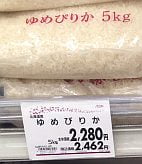 pricier than Hong Kong. Unless you’re buying rice. The 5kg bag on the right was going for the equivalent of HK$175/US$22; our much-despised Park N Shop chain sells the same amount for HK$40 – less than a quarter the Japanese price. Of course, Hong Kong’s rice is different and comes from swarthy places like Thailand and Vietnam and is unsuitable for Japanese people’s more-advanced and delicate digestive systems, so imports are shunned.
pricier than Hong Kong. Unless you’re buying rice. The 5kg bag on the right was going for the equivalent of HK$175/US$22; our much-despised Park N Shop chain sells the same amount for HK$40 – less than a quarter the Japanese price. Of course, Hong Kong’s rice is different and comes from swarthy places like Thailand and Vietnam and is unsuitable for Japanese people’s more-advanced and delicate digestive systems, so imports are shunned.
The dog-worshipping cult has not caught on in Japan as much as it has in Hong Kong, but it’s there. Every supermarket has a section for canine bento and similar inanities, and public transport signage urges mutt-carriers to keep their yappy, smelly, biting baby-substitutes out of innocent people’s way…
‘Smart and Human’ is a university motto – so much more to the point than that pretentious ‘Floreat blah blah Veritas’ stuff.
To a visitor from Hong Kong, the most impressive thing about Japan is how they’ve mastered the basic quality-of-life thing. Cushioned seats on the subway and warmed toilets are perhaps excessive. But the standard of everyday planning is a reminder of how badly Hong Kong has been screwed up by psychopath-bureaucrats who put cars before bicycles and pedestrians, and treat urban space as a resource to be horded and gifted to tycoons rather than as a community asset. Hong Kong needs to learn from Japan’s livability because the 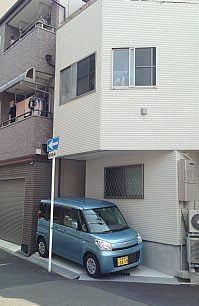 country offers us a glimpse of our own future – and that future is old. You have never seen so many seniors. The elderly are not a fringe minority in Japan: they are virtually the default, average, dominant (and pushy) demographic, and the young and middle-aged are subgroups, grateful if they can find somewhere to sit on the bus.
country offers us a glimpse of our own future – and that future is old. You have never seen so many seniors. The elderly are not a fringe minority in Japan: they are virtually the default, average, dominant (and pushy) demographic, and the young and middle-aged are subgroups, grateful if they can find somewhere to sit on the bus.
Japan is also renowned for being neat and tidy, which indeed it is in many ways. There’s a sort of compactness and straight-edgedness to the urban environment, from the street grid with intersecting level-crossings at sharp angles, to the boxy little houses apparently built randomly in no particular order but nonetheless precisely and efficiently crammed together. But aesthetics and design are upside-down. The ikebana-like presentation of food and the bamboo groves in temples are painstakingly planned and executed, but a map of a basic Y-shaped tram network comes out like this incomprehensible mess…
Which brings me to the best bit: the semi-Eraserhead ambience from all those great bundles of electrical and telecoms spaghetti dangling, looping and drooping above your head all over the place…
If they could find a way to put water and sewerage pipes up there, they would do it.


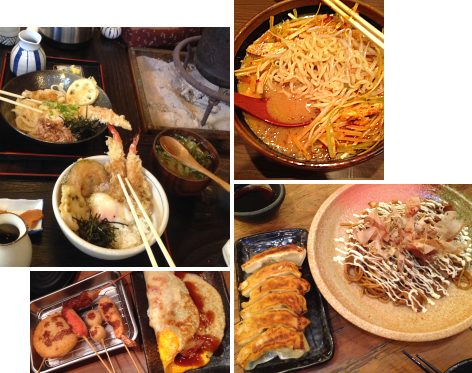
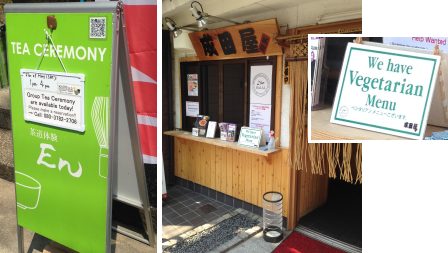
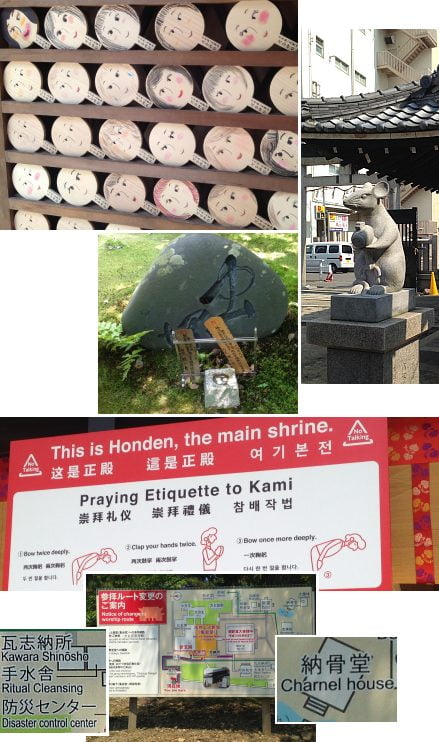
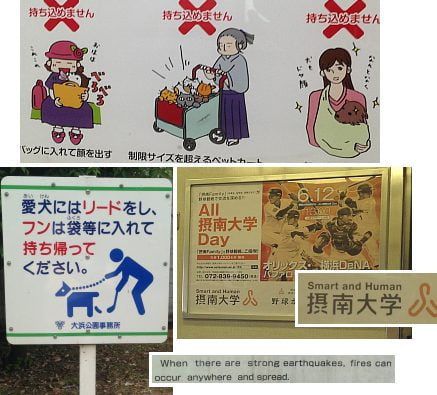
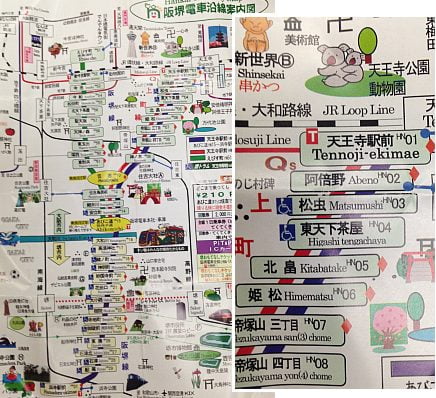
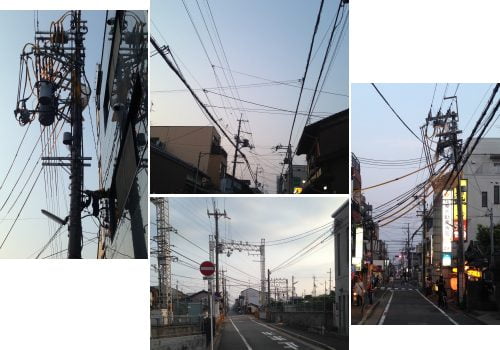
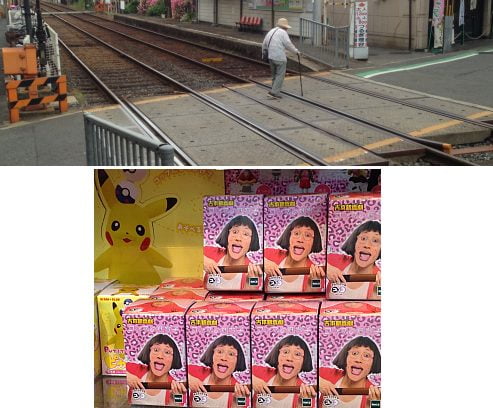
Did you mention the legover?
The Japanese are sanitized and twee. But the girls are so willing. In the end though, I was always glad to get back to rude, Philistine Hong Kong. The Japanese are too much like the Swiss. But without the jokes.
Thanks for the insights.
The whole of Japan, with its civilised, middle-class, humane art of living, shows up the barbarian hordes closer to home. These days, any large, upmarket hotel or restaurant close to a direct-link airport tends to be near-unliveable.
What I like about the domestic architecture is its practicality, efficiency, human scale and above all trust. No bars on 2oth floor windows, no boar-traps, no yappy chihuahuas on the tables, no one-way glass, no “security” guards, no pitched battles over parking.
Admittedly, if you travel to eat, all that delicate food can make you yearn for some deep-fried pig fat or noodles-with-dripping.
And there must be deep tensions in Japanese society, repressed, banished to the proletarian suburbs or yakuza HQs. Girlies’ knickers, unrelenting ethnocentrism, incestuous mass-rape mangas and WWII atrocities must surely out, sooner or later.
PD You forgot to mention anal retentiveness!
Those Jap bogs with bidet function are fantastic. Some public toilets have them!
And, Hemlock, you obviously haven’t been to Midtown Roppongi. There’s a complete doggy owner shop – pedicure, massage and food!
Also, Hemlock, if you’d gone to Japan last year the exchange rate was about 10% cheaper.
To be fair, “Smart and Human” is English for Japanese consumption, and looking at this explanation
http://www.setsunan.ac.jp/aboutus/symbol.html
It comes out as being more like Wisdom and Human Connectivity or something along those lines.